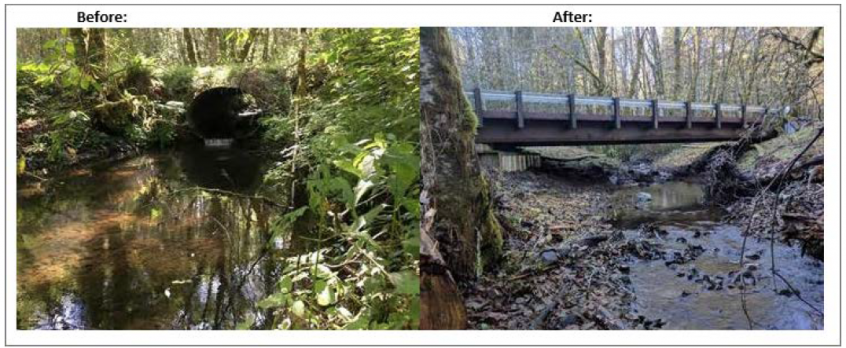Coho salmon, steelhead, trout, and other native Pacific Northwest fish are reaching new stretches of the Clatskanie River and its tributaries, thanks to recent efforts by Hancock Forest Management, a Manulife Investment Management company, in cooperation with the Columbia Soil and Water Conservation District. The projects were identified in the Lower Columbia River Partnership developed through the Regional Conservation Partnership Program.
Hancock Forest Management is a Washington Forest Protection Association member with about 1.2 million acres of forested land in the Pacific Northwest.
The foresters in the Columbia River Unit based in Cathlamet manage approximately 150,000 acres in Southwest Washington and Northwest Oregon. On the Washington side of the river, Hancock has been doing stream restoration since 2006. Hancock’s Cathlamet team has opened nearly 90 miles of fish-bearing streams, removed 68 old culverts and bridges, installed 173 new culverts and bridges, and upgraded or decommissioned over 1,250 miles of forest roads.
Hancock’s most recent project, just completed in November 2019, removed a large culvert that had prevented fish passage to 5.5 miles of essential fish habitat for Coho Salmon as well as Steelhead. This habitat, on an unnamed tributary of the Clatskanie River near its headwaters, is primarily spawning grounds with some rearing capacity. The Coho are listed for protection under the federal Endangered Species Act.
The culvert, which was on an active logging road, was 35 feet long and 5 feet wide. The fish barrier had been identified by the Oregon Department of Fish and Wildlife (ODFW) as a priority for removal. In place of the culvert, Hancock Forest Management built a single-lane 55-foot steel modular bridge. The project design not only created fish passage but protected an adjacent wetland complex, important for rearing habitats as well as a refuge for young fish from high flow events. The bridge project is within Hancock managed lands in Columbia County, outside of St. Helens, Oregon.
In 2018, Hancock Forest Management completed another project in the headwaters of the Clatskanie, on Dribble Creek, which opened up access for Coho and Steelhead to just over a mile of habitat, primarily for spawning. In this case, in addition to removing an undersized culvert, this project involved significant stream restoration work. Hancock Forest Management sloped back the existing road grade and placed large trees and boulders to allow Dribble Creek a more natural course and flow corresponding with the natural setting.
Nathan Herr, Acting District Manager of Columbia Soil and Water Conservation District, said “Hancock Forest Management has been a great partner with the District in restoring our local streams. We already are looking at more projects with Hancock.”
Stephan Dillon, Region Manager of Hancock Forest Management’s Columbia River Region unit, said “We’re excited to help Coho Salmon and steelhead flourish in the Clatskanie River as a result of our stream projects. Our goal is to protect wildlife and sustain fish on our lands.”
The Hancock Forest Management culvert removal projects are among thousands of projects to remove fish barriers in the Pacific Northwest. In fact, private forestland owners have helped to lead the way in stewardship efforts, protecting fish habitat and doing their part to restore and promote salmon recovery.
The Pacific Northwest is fortunate that private forestland owners such as Hancock Forest Management recognize the importance of investing in the region’s natural resources and have committed to protecting fish habitat and restoring salmon populations. Much of the progress would not be possible without leadership and buy-in from both large and small forestland owners.
Through Washington State’s historic Forests & Fish Law, and in collaboration with public agencies, tribal governments, researchers, and environmental groups, private forestland owners have worked to protect 60,000 miles of streams running through 9.3 million acres of state and private forested areas in Washington State. To date, private forestland owners have:
- Removed more than 7,900 fish passage barriers
- Invested $314 million to remove, replace or abandon forested roads to help protect fish habitat
- Opened more than 5,200 miles of historic fish habitat
- Set a goal of clearing all fish passage barriers by 2021
And last year, Gov. Jay Inslee announced that the Washington State Department of Transportation (WSDOT) would begin repairing and replacing state-owned highway culverts that impede fish migration. The executive order increased state investments in fish passage repairs from the Legislature’s $100 million for the biennium to a total of $275 million over the next two years. Money for the additional $175 million would come from the WSDOT budget.
At the time, Gov. Inslee stated that the increased investments was a “matter of urgency” and that on top of complying with a federal court order, the added money would allow WSDOT to “more than double its current pace of culvert repairs” to benefit wildlife, salmon, orca whales and the state’s economy.
Footnote:
The Washington Forest Protection Association (WFPA) is a trade association representing private forest landowners in Washington State. Hancock Natural Resource Group, a Manulife Investment Management Company is a member of WFPA.
The Columbia Soil and Water Conservation District (SWCD) was created in 1946 and offers free services to the local residents and landowners in Columbia County. To date, there are 45 districts serving Oregon. They are considered subdivisions of state government, but function as local units led by a locally elected board of directors. The Columbia SWCD is non-regulatory, and works with willing landowners to prevent problems and solve issues that arise from a variety of land use practices.
Neither the WFPA nor the SWCDs of Oregon are affiliated with Manulife or Hancock Natural Resource Group and are not endorsing any investment strategy or investment product sponsored by Manulife or Hancock Natural Resource Group.
